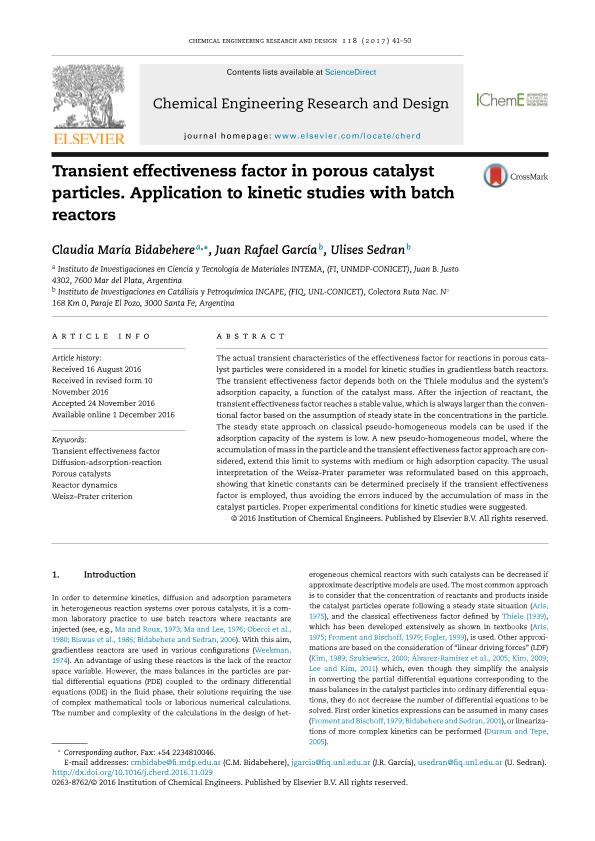Mostrar el registro sencillo del ítem
dc.contributor.author
Bidabehere, Claudia María

dc.contributor.author
García, Juan Rafael

dc.contributor.author
Sedran, Ulises Anselmo

dc.date.available
2018-04-17T17:22:43Z
dc.date.issued
2017-02
dc.identifier.citation
Bidabehere, Claudia María; García, Juan Rafael; Sedran, Ulises Anselmo; Transient effectiveness factor in porous catalyst particles. Application to kinetic studies with batch reactors; Institution of Chemical Engineers; Chemical Engineering Research & Design; 118; 2-2017; 41-50
dc.identifier.issn
0263-8762
dc.identifier.uri
http://hdl.handle.net/11336/42308
dc.description.abstract
The actual transient characteristics of the effectiveness factor for reactions in porous catalyst particles were considered in a model for kinetic studies in gradientless batch reactors. The transient effectiveness factor depends both on the Thiele modulus and the system’s adsorption capacity, a function of the catalyst mass. After the injection of reactant, the transient effectiveness factor reaches a stable value, which is always larger than the conventional factor based on the assumption of steady state in the concentrations in the particle. The steady state approach on classical pseudo-homogeneous models can be used if the adsorption capacity of the system is low. A new pseudo-homogeneous model, where the accumulation of mass in the particle and the transient effectiveness factor approach are considered, extend this limit to systems with medium or high adsorption capacity. The usual interpretation of the Weisz–Prater parameter was reformulated based on this approach, showing that kinetic constants can be determined precisely if the transient effectiveness factor is employed, thus avoiding the errors induced by the accumulation of mass in the catalyst particles. Proper experimental conditions for kinetic studies were suggested.
dc.format
application/pdf
dc.language.iso
eng
dc.publisher
Institution of Chemical Engineers

dc.rights
info:eu-repo/semantics/openAccess
dc.rights.uri
https://creativecommons.org/licenses/by-nc-sa/2.5/ar/
dc.subject
Transient Effectiveness Factor
dc.subject
Diffusion-Adsorption-Reaction
dc.subject
Porous Catalysts
dc.subject
Reactor Dynamics
dc.subject
Weisz–Prater Criterion
dc.subject.classification
Otras Ingeniería Química

dc.subject.classification
Ingeniería Química

dc.subject.classification
INGENIERÍAS Y TECNOLOGÍAS

dc.title
Transient effectiveness factor in porous catalyst particles. Application to kinetic studies with batch reactors
dc.type
info:eu-repo/semantics/article
dc.type
info:ar-repo/semantics/artículo
dc.type
info:eu-repo/semantics/publishedVersion
dc.date.updated
2018-04-13T14:23:38Z
dc.journal.volume
118
dc.journal.pagination
41-50
dc.journal.pais
Reino Unido

dc.description.fil
Fil: Bidabehere, Claudia María. Consejo Nacional de Investigaciones Científicas y Técnicas. Centro Científico Tecnológico Conicet - Mar del Plata. Instituto de Investigaciones en Ciencia y Tecnología de Materiales. Universidad Nacional de Mar del Plata. Facultad de Ingeniería. Instituto de Investigaciones en Ciencia y Tecnología de Materiales; Argentina
dc.description.fil
Fil: García, Juan Rafael. Consejo Nacional de Investigaciones Científicas y Técnicas. Centro Científico Tecnológico Conicet - Santa Fe. Instituto de Investigaciones en Catálisis y Petroquímica ; Argentina
dc.description.fil
Fil: Sedran, Ulises Anselmo. Consejo Nacional de Investigaciones Científicas y Técnicas. Centro Científico Tecnológico Conicet - Santa Fe. Instituto de Investigaciones en Catálisis y Petroquímica ; Argentina
dc.journal.title
Chemical Engineering Research & Design

dc.relation.alternativeid
info:eu-repo/semantics/altIdentifier/doi/https://doi.org/10.1016/j.cherd.2016.11.029
dc.relation.alternativeid
info:eu-repo/semantics/altIdentifier/url/https://www.sciencedirect.com/science/article/pii/S0263876216304622
Archivos asociados
